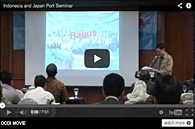An English version of the “Technical Standards and Commentaries for Port and Harbour Facilities in Japan” has been issued by OCDI.
An English version of the “Technical Standards and Commentaries for Port and Harbour Facilities in Japan” covering the Japanese Standards which came into effect in the year 2018 under the Port and Harbour Act was translated by the Overseas Coastal Area Development Institute of Japan (OCDI) in December 2020. The contents of the English version Technical Standards are given below.
The first Japanese manual on port and harbor technology was published in 1943 and was subsequently revised several times. Under the 1974 revision of the Port and Harbour Law, “The Technical Standards for Port and Harbour Facilities” are provided in the form of ministerial ordinances. It has been revised four times as of this writing. Historically, large numbers of port facilities in Japan as well as overseas Japanese ODA projects have been planned and designed according to the Technical Standards.
Because many ports in Japan face the open sea and/or are located on one of the world’s most vigorous earthquake active areas, a considerable number of ports are exposed to severe wave conditions as well as earthquakes and tsunamis. It is fair to say that Japan has the world’s most advanced level of technology for wave-resistant design, earthquake-resistant design and for countermeasures to cope with soft ground at port and harbor areas.
An English version of the “Technical Standards and Commentaries for Port and Harbour Facilities in Japan” covering the Japanese Standards which came into effect in the year 2018 under the Port and Harbour Act was translated by the Overseas Coastal Area Development Institute of Japan (OCDI) in December 2020. The contents of the English version Technical Standards are given below.
Another distinguishing feature of the Technical Standards is the adoption of the performance-based design method conforming to WTO required ISO 2394, ISO 23469 and ISO 21650. The Technical Standards which describe state-of-the-art technology are believed to be indispensable for engineers in charge of design, construction and maintenance of port and harbor facilities as well as persons engaging in port management and operation.
It is our sincere hope that “the Technical Standards” will contribute to the effective development of ports and harbors and to progress in port and harbor technology. The English version of Japanese port technical standards is available on OCDI’s Web Site at http://www.ocdi.or.jp/en/.
The contents of the English version Technical Standards
Part I General Section; Chapters 1. General Rules, 2. Construction, Improvement and Maintenance of Facilities Subject to the Technical Standards, and 3. Consideration for Environment
Part II Actions and Material Strength Requirements Section; Chapters 1. General, 2. Meteorology and Oceanography, 3. Geotechnical Conditions, 4. Earth Pressures and Water Pressures, 5. Ground Settlement, 6. Earthquakes, 7. Ground Liquefaction, 8. Ships, 9. Environmental Actions, 10. Self-Weight and Surcharge, and 11. Materials
Part III Port Facility Section; Chapters 1. General, 2. Items Common to Facilities Subject to Technical Standards, 3. Waterways and Basins, 4. Protective Facilities for Harbors, 5. Mooring Facilities, 6. Port Transportation Facilities, 7. Cargo Sorting Facilities, 8. Storage Facilities, 9. Facilities for Ship Service, 10. Mobile Facilities, and 11. Other Port Facilities.
Part IV Reference Technical Data for Part I
Part V Reference Technical Data for Part II
Part VI Reference Technical Data for Part III












